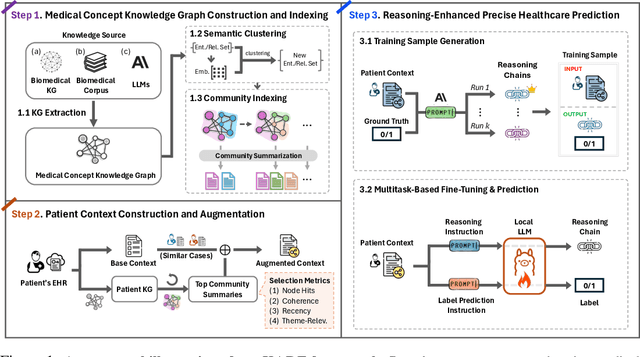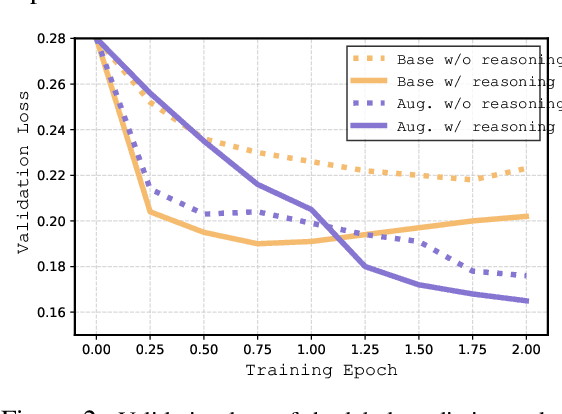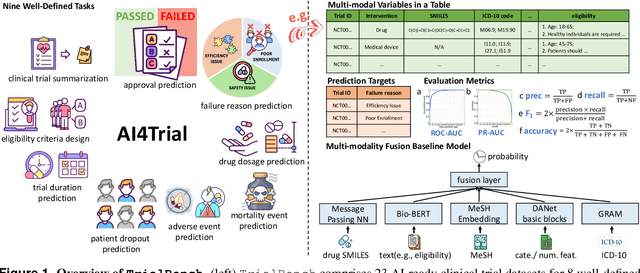Cao Xiao
Enhancing SAM with Efficient Prompting and Preference Optimization for Semi-supervised Medical Image Segmentation
Mar 06, 2025Abstract:Foundational models such as the Segment Anything Model (SAM) are gaining traction in medical imaging segmentation, supporting multiple downstream tasks. However, such models are supervised in nature, still relying on large annotated datasets or prompts supplied by experts. Conventional techniques such as active learning to alleviate such limitations are limited in scope and still necessitate continuous human involvement and complex domain knowledge for label refinement or establishing reward ground truth. To address these challenges, we propose an enhanced Segment Anything Model (SAM) framework that utilizes annotation-efficient prompts generated in a fully unsupervised fashion, while still capturing essential semantic, location, and shape information through contrastive language-image pretraining and visual question answering. We adopt the direct preference optimization technique to design an optimal policy that enables the model to generate high-fidelity segmentations with simple ratings or rankings provided by a virtual annotator simulating the human annotation process. State-of-the-art performance of our framework in tasks such as lung segmentation, breast tumor segmentation, and organ segmentation across various modalities, including X-ray, ultrasound, and abdominal CT, justifies its effectiveness in low-annotation data scenarios.
MedHEval: Benchmarking Hallucinations and Mitigation Strategies in Medical Large Vision-Language Models
Mar 04, 2025Abstract:Large Vision Language Models (LVLMs) are becoming increasingly important in the medical domain, yet Medical LVLMs (Med-LVLMs) frequently generate hallucinations due to limited expertise and the complexity of medical applications. Existing benchmarks fail to effectively evaluate hallucinations based on their underlying causes and lack assessments of mitigation strategies. To address this gap, we introduce MedHEval, a novel benchmark that systematically evaluates hallucinations and mitigation strategies in Med-LVLMs by categorizing them into three underlying causes: visual misinterpretation, knowledge deficiency, and context misalignment. We construct a diverse set of close- and open-ended medical VQA datasets with comprehensive evaluation metrics to assess these hallucination types. We conduct extensive experiments across 11 popular (Med)-LVLMs and evaluate 7 state-of-the-art hallucination mitigation techniques. Results reveal that Med-LVLMs struggle with hallucinations arising from different causes while existing mitigation methods show limited effectiveness, especially for knowledge- and context-based errors. These findings underscore the need for improved alignment training and specialized mitigation strategies to enhance Med-LVLMs' reliability. MedHEval establishes a standardized framework for evaluating and mitigating medical hallucinations, guiding the development of more trustworthy Med-LVLMs.
Deep Linear Hawkes Processes
Dec 27, 2024Abstract:Marked temporal point processes (MTPPs) are used to model sequences of different types of events with irregular arrival times, with broad applications ranging from healthcare and social networks to finance. We address shortcomings in existing point process models by drawing connections between modern deep state-space models (SSMs) and linear Hawkes processes (LHPs), culminating in an MTPP that we call the deep linear Hawkes process (DLHP). The DLHP modifies the linear differential equations in deep SSMs to be stochastic jump differential equations, akin to LHPs. After discretizing, the resulting recurrence can be implemented efficiently using a parallel scan. This brings parallelism and linear scaling to MTPP models. This contrasts with attention-based MTPPs, which scale quadratically, and RNN-based MTPPs, which do not parallelize across the sequence length. We show empirically that DLHPs match or outperform existing models across a broad range of metrics on eight real-world datasets. Our proposed DLHP model is the first instance of the unique architectural capabilities of SSMs being leveraged to construct a new class of MTPP models.
Dynamic Uncertainty Ranking: Enhancing In-Context Learning for Long-Tail Knowledge in LLMs
Oct 31, 2024Abstract:Large language models (LLMs) can learn vast amounts of knowledge from diverse domains during pre-training. However, long-tail knowledge from specialized domains is often scarce and underrepresented, rarely appearing in the models' memorization. Prior work has shown that in-context learning (ICL) with retriever augmentation can help LLMs better capture long-tail knowledge, reducing their reliance on pre-trained data. Despite these advances, we observe that LLM predictions for long-tail questions remain uncertain to variations in retrieved samples. To take advantage of the uncertainty in ICL for guiding LLM predictions toward correct answers on long-tail samples, we propose a reinforcement learning-based dynamic uncertainty ranking method for ICL that accounts for the varying impact of each retrieved sample on LLM predictions. Our approach prioritizes more informative and stable samples while demoting misleading ones, updating rankings based on the feedback from the LLM w.r.t. each retrieved sample. To enhance training efficiency and reduce query costs, we introduce a learnable dynamic ranking threshold, adjusted when the model encounters negative prediction shifts. Experimental results on various question-answering datasets from different domains show that our method outperforms the best baseline by $2.76\%$, with a notable $5.96\%$ boost in accuracy on long-tail questions that elude zero-shot inference.
Reasoning-Enhanced Healthcare Predictions with Knowledge Graph Community Retrieval
Oct 06, 2024



Abstract:Large language models (LLMs) have demonstrated significant potential in clinical decision support. Yet LLMs still suffer from hallucinations and lack fine-grained contextual medical knowledge, limiting their high-stake healthcare applications such as clinical diagnosis. Traditional retrieval-augmented generation (RAG) methods attempt to address these limitations but frequently retrieve sparse or irrelevant information, undermining prediction accuracy. We introduce KARE, a novel framework that integrates knowledge graph (KG) community-level retrieval with LLM reasoning to enhance healthcare predictions. KARE constructs a comprehensive multi-source KG by integrating biomedical databases, clinical literature, and LLM-generated insights, and organizes it using hierarchical graph community detection and summarization for precise and contextually relevant information retrieval. Our key innovations include: (1) a dense medical knowledge structuring approach enabling accurate retrieval of relevant information; (2) a dynamic knowledge retrieval mechanism that enriches patient contexts with focused, multi-faceted medical insights; and (3) a reasoning-enhanced prediction framework that leverages these enriched contexts to produce both accurate and interpretable clinical predictions. Extensive experiments demonstrate that KARE outperforms leading models by up to 10.8-15.0% on MIMIC-III and 12.6-12.7% on MIMIC-IV for mortality and readmission predictions. In addition to its impressive prediction accuracy, our framework leverages the reasoning capabilities of LLMs, enhancing the trustworthiness of clinical predictions.
BIPEFT: Budget-Guided Iterative Search for Parameter Efficient Fine-Tuning of Large Pretrained Language Models
Oct 04, 2024



Abstract:Parameter Efficient Fine-Tuning (PEFT) offers an efficient solution for fine-tuning large pretrained language models for downstream tasks. However, most PEFT strategies are manually designed, often resulting in suboptimal performance. Recent automatic PEFT approaches aim to address this but face challenges such as search space entanglement, inefficiency, and lack of integration between parameter budgets and search processes. To overcome these issues, we introduce a novel Budget-guided Iterative search strategy for automatic PEFT (BIPEFT), significantly enhancing search efficiency. BIPEFT employs a new iterative search strategy to disentangle the binary module and rank dimension search spaces. Additionally, we design early selection strategies based on parameter budgets, accelerating the learning process by gradually removing unimportant modules and fixing rank dimensions. Extensive experiments on public benchmarks demonstrate the superior performance of BIPEFT in achieving efficient and effective PEFT for downstream tasks with a low parameter budget.
Unlocking Memorization in Large Language Models with Dynamic Soft Prompting
Sep 20, 2024



Abstract:Pretrained large language models (LLMs) have revolutionized natural language processing (NLP) tasks such as summarization, question answering, and translation. However, LLMs pose significant security risks due to their tendency to memorize training data, leading to potential privacy breaches and copyright infringement. Accurate measurement of this memorization is essential to evaluate and mitigate these potential risks. However, previous attempts to characterize memorization are constrained by either using prefixes only or by prepending a constant soft prompt to the prefixes, which cannot react to changes in input. To address this challenge, we propose a novel method for estimating LLM memorization using dynamic, prefix-dependent soft prompts. Our approach involves training a transformer-based generator to produce soft prompts that adapt to changes in input, thereby enabling more accurate extraction of memorized data. Our method not only addresses the limitations of previous methods but also demonstrates superior performance in diverse experimental settings compared to state-of-the-art techniques. In particular, our method can achieve the maximum relative improvement of 112.75% and 32.26% over the vanilla baseline in terms of discoverable memorization rate for the text generation task and code generation task respectively.
TrialBench: Multi-Modal Artificial Intelligence-Ready Clinical Trial Datasets
Jun 30, 2024



Abstract:Clinical trials are pivotal for developing new medical treatments, yet they typically pose some risks such as patient mortality, adverse events, and enrollment failure that waste immense efforts spanning over a decade. Applying artificial intelligence (AI) to forecast or simulate key events in clinical trials holds great potential for providing insights to guide trial designs. However, complex data collection and question definition requiring medical expertise and a deep understanding of trial designs have hindered the involvement of AI thus far. This paper tackles these challenges by presenting a comprehensive suite of meticulously curated AIready datasets covering multi-modal data (e.g., drug molecule, disease code, text, categorical/numerical features) and 8 crucial prediction challenges in clinical trial design, encompassing prediction of trial duration, patient dropout rate, serious adverse event, mortality rate, trial approval outcome, trial failure reason, drug dose finding, design of eligibility criteria. Furthermore, we provide basic validation methods for each task to ensure the datasets' usability and reliability. We anticipate that the availability of such open-access datasets will catalyze the development of advanced AI approaches for clinical trial design, ultimately advancing clinical trial research and accelerating medical solution development. The curated dataset, metrics, and basic models are publicly available at https://github.com/ML2Health/ML2ClinicalTrials/tree/main/AI4Trial.
Synthesizing Multimodal Electronic Health Records via Predictive Diffusion Models
Jun 20, 2024



Abstract:Synthesizing electronic health records (EHR) data has become a preferred strategy to address data scarcity, improve data quality, and model fairness in healthcare. However, existing approaches for EHR data generation predominantly rely on state-of-the-art generative techniques like generative adversarial networks, variational autoencoders, and language models. These methods typically replicate input visits, resulting in inadequate modeling of temporal dependencies between visits and overlooking the generation of time information, a crucial element in EHR data. Moreover, their ability to learn visit representations is limited due to simple linear mapping functions, thus compromising generation quality. To address these limitations, we propose a novel EHR data generation model called EHRPD. It is a diffusion-based model designed to predict the next visit based on the current one while also incorporating time interval estimation. To enhance generation quality and diversity, we introduce a novel time-aware visit embedding module and a pioneering predictive denoising diffusion probabilistic model (PDDPM). Additionally, we devise a predictive U-Net (PU-Net) to optimize P-DDPM.We conduct experiments on two public datasets and evaluate EHRPD from fidelity, privacy, and utility perspectives. The experimental results demonstrate the efficacy and utility of the proposed EHRPD in addressing the aforementioned limitations and advancing EHR data generation.
Certifiably Byzantine-Robust Federated Conformal Prediction
Jun 04, 2024



Abstract:Conformal prediction has shown impressive capacity in constructing statistically rigorous prediction sets for machine learning models with exchangeable data samples. The siloed datasets, coupled with the escalating privacy concerns related to local data sharing, have inspired recent innovations extending conformal prediction into federated environments with distributed data samples. However, this framework for distributed uncertainty quantification is susceptible to Byzantine failures. A minor subset of malicious clients can significantly compromise the practicality of coverage guarantees. To address this vulnerability, we introduce a novel framework Rob-FCP, which executes robust federated conformal prediction, effectively countering malicious clients capable of reporting arbitrary statistics with the conformal calibration process. We theoretically provide the conformal coverage bound of Rob-FCP in the Byzantine setting and show that the coverage of Rob-FCP is asymptotically close to the desired coverage level. We also propose a malicious client number estimator to tackle a more challenging setting where the number of malicious clients is unknown to the defender and theoretically shows its effectiveness. We empirically demonstrate the robustness of Rob-FCP against diverse proportions of malicious clients under a variety of Byzantine attacks on five standard benchmark and real-world healthcare datasets.
 Add to Chrome
Add to Chrome Add to Firefox
Add to Firefox Add to Edge
Add to Edge